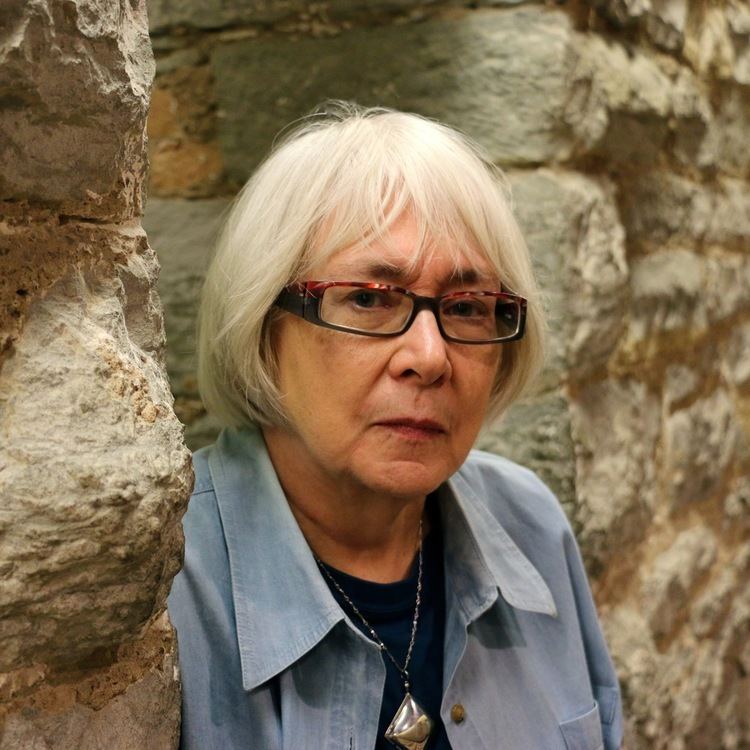Nationality American Name Eleanor Arnason | Role Author | |
 | ||
Born December 28, 1942 (age 82) ( 1942-12-28 ) New York City, United States Books Ring of swords, A Woman of the Iron People Awards James Tiptree, Jr. Award Nominations Hugo Award for Best Novelette | ||
Eleanor Arnason Interview, October 2003
Eleanor Atwood Arnason (born December 28, 1942) is an American author of science fiction novels and short stories.
Contents
- Eleanor Arnason Interview October 2003
- Background
- Politics
- Standalone Novels
- Standalone Short Stories
- Hwarhath Stories
- Lydia Duluth stories
- Collections
- Anthologies
- Poems
- References
Arnason's earliest published story, "A Clear Day in the Motor City", appeared in New Worlds in 1973. Her work often depicts cultural change and conflict, usually from the viewpoint of characters who cannot or will not live by their own societies' rules. This anthropological focus has led many to compare her fiction to that of Ursula K. Le Guin.
Arnason won the first James Tiptree, Jr. Award, the Mythopoeic Award (for A Woman of the Iron People), the Spectrum Award (for "Dapple") and the HOMer Award (for her novelette Stellar Harvest). Stellar Harvest was also nominated for a Hugo Award in 2000. In 2003, she was nominated for two Nebula Awards, for her novella Potter of Bones and her short story "Knapsack Poems". In 2004, she was guest of honor at WisCon. She lives in Minnesota.
Background
Eleanor Arnason is the daughter of Hjorvadur Harvard Arnason, a Canadian-born man of Icelandic descent, who worked as an art historian and became the director of the Walker Art Center in Minneapolis, Minnesota, in 1951, and Elizabeth Hickcox Yard Arnason, a social worker by profession who spent her childhood in a missionary community in western China. Arnason is the niece of the American feminist Molly Yard, and her maternal grandparents were both Methodist missionaries. This Methodist influence would be visible in her works, most notably in Ring of Swords.
From 1949 to 1960, Arnason and her parents lived in Walker's "Idea House #2", a futuristic dwelling built next to the Walker Art Center. [1] Arnason has said that her experience growing up around avant-garde artists in a futurist house, in addition to the influence of her feminist, socialist mother contributed to her preoccupation with the future, and consequently science fiction. Prior to 1949, Arnason's family moved frequently: from New York City to Chicago; Washington, D.C.; London; Paris; and St. Paul, Minnesota.
She graduated from Swarthmore College in 1964, with a B.A. in art history, and continued her education in graduate school at the University of Minnesota, until 1967. She spent the next seven years working as an office clerk in Brooklyn and then Detroit. Her time in these blue-collar, racially diverse areas helped to shape her understanding about class consciousness, conflict, and revolution—notions that are reflected in her works. Arnason moved back to the Twin Cities of Minneapolis and St. Paul in 1974 and continued to work in offices, warehouses, a large art museum, and more recently, a series of small nonprofits devoted to history, peace, justice, and art.
Since 1994, she has shifted her literary focus from novels to short fiction. She retired in 2009 and now writes full-time.
Politics
The issues that transpire most in Arnason's life and writings encompass feminism, peace, social justice, support for the union movement and a deep belief that racism and all forms of prejudice should be opposed. City Pages labelled Arnason as a political radical.
Having come of age during Second Wave Feminism, Arnason included gender and sexuality as central themes in her work, notably in her collection of hwarhath stories in which she "wanted to create a society in which homosexual love was normal and heterosexual love was abnormal, sort of as a thought experiment. And because contemporary Americans have very rigid ideas of what is normal." The hwarhath stories also addressed issues of gender roles and reproductive rights.
She was profoundly affected by the McCarthy period, particularly because of the ways that children were taught to securitize against nuclear annihilation. She became involved in the Student Peace Union and attended demonstrations during the Cuban missile crisis. Ring of Swords, Arnason's hwarwath novel, illustrates peace building after a long war; an endeavor both representative of Arnason's peace beliefs and of the Make love, not war politics of the 1960s.
In 1963, Arnason went to the March on Washington for Jobs and Freedom with her mother. This had a profound impact that would be reflected in her story Big Brown Mama and Brer Rabbit in which Brer Rabbit transforms into an African-American man in the early 20th century. Arnason has often opted for racially diverse characters, including, but not limited to, a heroine of Chinese descent in A Woman of the Iron People and a Hispanic heroine in Ring of Swords. In addition, her Lydia Duluth stories present a future in which an overwhelming majority of humans have dark brown and black toned skins as the best protection against the radiation of many stars.
Arnason had intermittent activist politics outside of her work as an author, working in a campaign office in New York, collecting and transporting supplies for striking coal miners in Kentucky, becoming a local and national official in the National Writers Union and engaging in Democratic Farmer Labor Party precinct politics.
